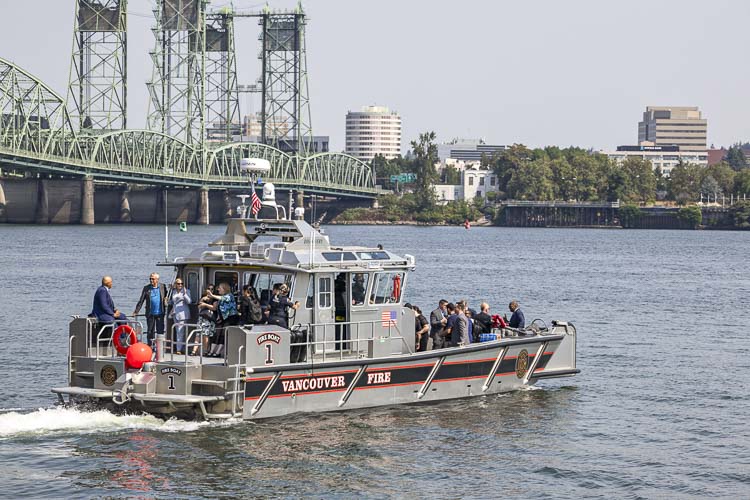
The grant, first announced last month, is the largest grant awarded to a single project by the agency under the $1.2 trillion Infrastructure Investment and Jobs Act
John Ley
for Clark County Today
Federal Highway Administrator Shailen Bhatt was in town Thursday to highlight the agency awarding the Interstate Bridge Replacement Program (IBR) $1.5 billion in a “mega grant.” The grant, first announced last month, is the largest grant awarded to a single project by the agency under the $1.2 trillion Infrastructure Investment and Jobs Act (IIJA).
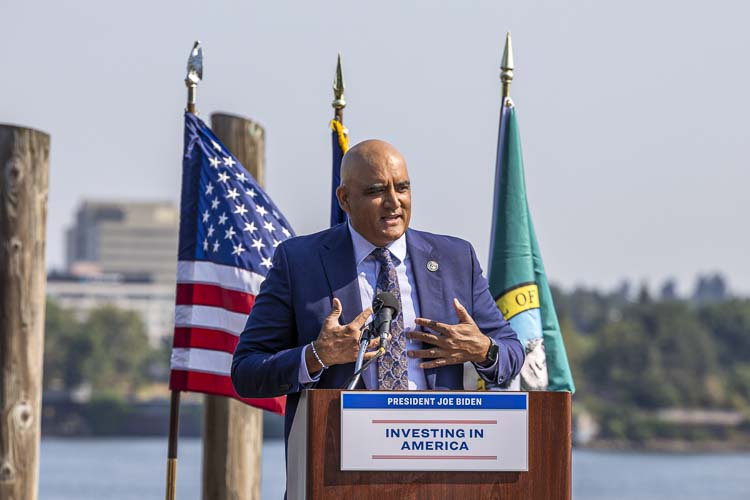
The ceremony on the deck of the Holiday Inn on Hayden Island, began with sirens going off announcing a bridge lift. IBR Administrator Greg Johnson said: “you couldn’t have scripted this any better” as vehicle traffic was stopped for a sailboat traveling west on the river. “Now you see what the issue is,” he said.
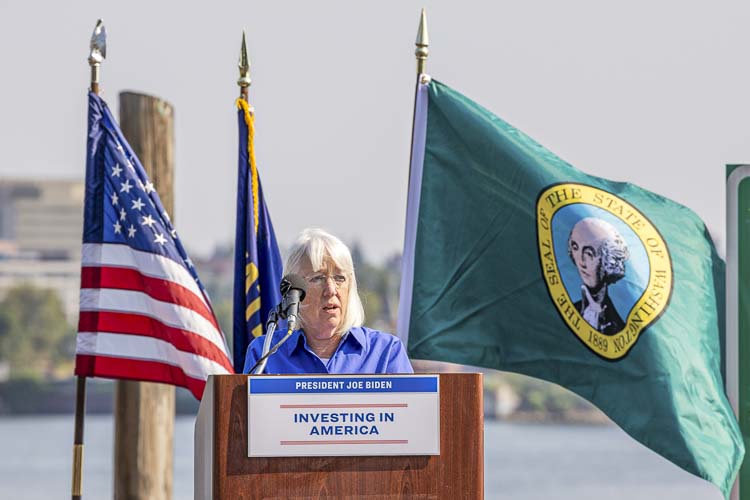
A number of elected officials were present, noting the “30-year-long battle” to make this happen. Washington Sen. Patty Murray emphasized that Portland congestion has hit 10 hours a day. “It steals countless hours from people” sitting stuck in their cars. Washington Sen. Maria Cantwell said this bridge was the “linchpin to international trade.”
While many speakers mentioned the traffic congestion negatively impacting freight haulers and people’s lives, none spoke about how spending the $7.5 billion (current price) will improve life for freight haulers or average citizens. The IBR team is projecting that by 2045, morning travel times from Salmon Creek to the Fremont Bridge will double, from 29 minutes to 60 minutes. Furthermore, they project half of rush hour traffic will be stuck going zero to 20 mph.
Bhatt shared that our transportation system is “the heartbeat of a vibrant economy.” He noted the current situation is a huge freight issue. Trucks stuck in congested traffic adds to inflation as products take longer in shipping.
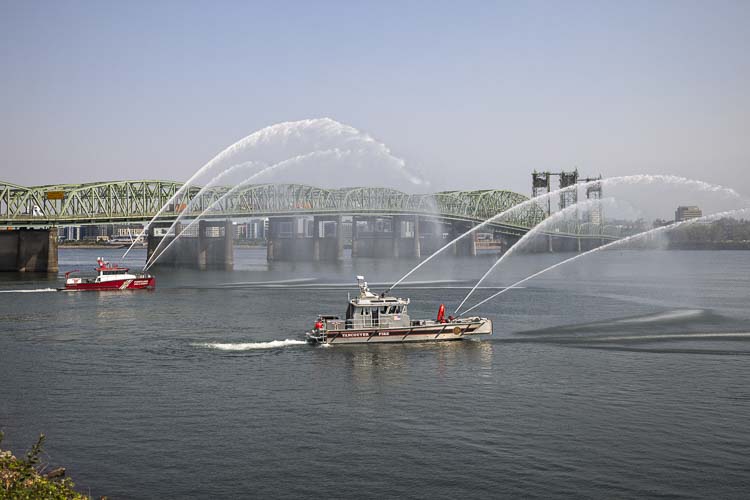
The grant is the largest award announced to date for any project through the FHWA’s Bridge Investment Program and the third federal grant awarded to the IBR program, according to the Washington State Department of Transportation (WSDOT). Previous grant awards include a $600 million grant through the federal Mega Grant program announced by the U.S. Department of Transportation earlier this year and a $1 million planning grant from the Bridge Investment Program announced in 2022.
“Under the Bipartisan Infrastructure Law’s Bridge Investment Program, we are making the single-largest dedicated investment in bridges since the construction of the interstate highway system,” said Bhatt. “Moreover, this grant in Oregon and Washington state is the largest of all the grants being awarded in this second round of funding. It’s helping to reinvest in our nation’s infrastructure and ensure vital connections for Americans that will improve safety, boost their quality of life, and deliver a transportation system that works for everyone.”
Several of the speakers mentioned the “red light” of a bridge lift to allow a sailboat to pass; but none mentioned that the Coast Guard has rejected the IBR’s 116-foot requested clearance as being too low for current maritime traffic users. The Coast Guard is demanding a bridge offering the current 178 feet, and would prefer “unlimited” clearance which could be provided by either a tunnel or a bascule bridge.
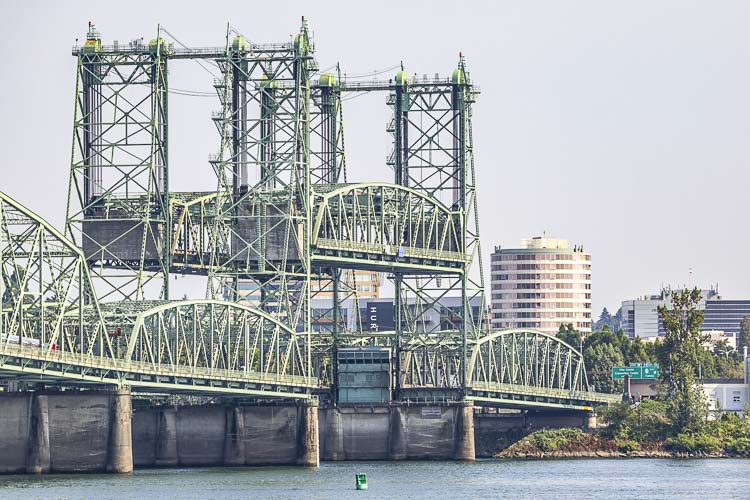
Clark County Today asked Bhatt’s office the following via email.
1. Several speakers today talked about there are currently 10 hours of congestion a day, and the $132 million of freight per day crossing the Columbia River, as part of the reason to spend “the largest grant” from the FHWA on our Interstate Bridge Replacement project.
Nobody in their comments answered the question “how much will traffic congestion be reduced” or freight mobility improved, by the expenditure of $7.5 billion taxpayer dollars, of which the FHWA has committed $2.1 billion.
Will the FHWA fund a project if it doesn’t reduce traffic congestion or save people time?
2. The current Locally Preferred Alternative includes a 3-mile light rail extension from north Portland into Vancouver for $2 billion, or over one quarter of the project’s cost. The IBR team has shared that 54 percent of the bridge surface area will be dedicated to pedestrians, bicyclists, and transit; with only 46 percent for freight haulers and cars.
They are replacing an over congested 3-lane bridge with another 3 through lane bridge, that offers more space for “active transportation & transit” than it does for cars and trucks.
Given the importance of moving freight to our nation’s economy, shouldn’t an interstate highway and bridge dedicate more surface area for cars and trucks than it does for bikers, pedestrians, and sparsely used transit?
Here is the FHWA response on background (received from an FHWA spokesperson:
Q1: Will the FHWA fund a project if it doesn’t reduce traffic congestion or save people time? The Bridge Investment Program/Large Bridge Project Grant included criteria to evaluate applications based on impacts on economic competitiveness and opportunity, including the increased efficiency of freight movement, improved supply chains, congestion reduction and travel time reliability.
Note that congestion is caused by several transportation issues in the program area. The sub-standard design of the current Interstate Bridge and closely spaced interchanges in the program area contribute significantly to congestion and slower moving vehicles. Narrow lane widths, reduced sight distance due to the bridge hump and freeway curve approaching the Interstate Bridge in Vancouver contribute to congestion and vehicles slowing down while crossing the Columbia River. A lack of safety shoulders also contributes to those problems. In addition, the seven interchanges in just five miles and short entrance and exit ramps on either side of the bridge contribute to congestion. Design improvements, safety shoulders throughout the corridor and the addition of auxiliary lanes to enhance ramp-to-ramp connections will help improve the flow of traffic both on the bridge and throughout the five-mile program corridor.
Q2: Given the importance of moving freight to our nation’s economy, shouldn’t an interstate highway and bridge dedicate more surface area for cars and trucks than it does for bikers, pedestrians, and sparsely used transit? The Bridge Investment Program/Large Bridge Project Grant included criteria to evaluate applications on impacts to safety and mobility, including multimodal accommodations for pedestrians and bicyclists.
The I-5 Bridge Replacement program is striving to address six transportation problems, including congestion. Investments in the program will also address earthquake vulnerability, safety, inadequate infrastructure for people who walk, bike or roll, limited public transportation and impaired freight movement. Many of the improvements the IBR program is proposing will last more than 100 years, including the investments in multimodal transportation so travelers have options for how they get across the river. All of the bridge configurations being studied in the Draft Supplemental Environmental Impact Statement would include investments to improve conditions for all travelers, including safer vehicle lanes, the addition of full safety shoulders, the addition of auxiliary lanes to improve ramp-to-ramp connections, high-capacity transit and improved pedestrian and bicycle facilities.
The I-5 is one of the only routes across the Columbia River in the Portland/Vancouver metro region and provides a critical community and economic connection for travelers between the states. Transit and active transportation are identified in the IBR program’s purpose and need as transportation problems that must be addressed. Active transportation and transit are a key part of centering equity in the IBR program to help ensure that people from all socioeconomic backgrounds will have access to efficient and affordable travel options. Both are also key elements that classify IBR, a federally funded transportation project, as a multimodal transportation program.
Also, the modified Locally Preferred Alternative being studied would include three through lanes in each direction similar to today. It would add one auxiliary lane in each direction, as well as full safety shoulders which do not exist on the existing bridge.
Also read:
- POLL: Should the I-5 Bridge project be paused over cost and bidding concerns?Clark County Today’s weekly poll asks whether the I-5 Bridge replacement should be paused as questions grow around rising costs and a lack of competitive bids.
- Opinion: TriMet contract: MAX vehicles cost $4.5 millionRep. John Ley examines TriMet’s MAX vehicle purchases, arguing most were replacements and not connected to the bridge project.
- Expect delays on I-5 near Woodland for bridge inspection, May 18WSDOT will close a lane of southbound I-5 near Woodland on May 18 for a safety inspection.
- Opinion: ‘I’m more than just a little skeptical that IBR officials are doing everything they can to limit the cost of this project’Ken Vance shares his concerns over rising costs and limited contractor interest in the Interstate Bridge Replacement Program.
- Letter: ‘IBR has relied on this video to instill fear in the public and government officials to promote the construction of a new bridge’Bob Ortblad questions IBR’s use of a seismic video and urges a shift toward tunnel alternatives in this critical letter to the editor.










Thank you for the great article, John Ley, and for continuing to write them!
I particularly liked this section:
“Several of the speakers mentioned the “red light” of a bridge lift to allow a sailboat to pass; but none mentioned that the Coast Guard has rejected the IBR’s 116-foot requested clearance as being too low for current maritime traffic users. The Coast Guard is demanding a bridge offering the current 178 feet, and would prefer “unlimited” clearance which could be provided by either a tunnel or a bascule bridge.”
Hmmm. It seems rather premature to me that there was this celebration, and that there was such a HUGE pile of money awarded for IBR’s nebulous ‘replacement’ I-5 Bridge in the first place! When you seriously consider the clearly stated vertical height requirements for marine traffic by the USCG, it seems like these officials and IBRP are behaving a bit like a bunch of ostriches with their heads in the sand!
BTW, the thought of light rail stations way up high in the air where they are more exposed to the elements, dependent on elevators, and knowing about the existing CRIME problems, will definitely be enough for me to want to stay well away from this ‘replacement’. I don’t think I will be the only one.
Also, if IBR’s bridge is supposedly going to be more earthquake resilient than what we have already, then why have elevators!? They generally don’t do well when there is shaking, and the general advice is not to enter one if there is an earthquake. So there will be stairs too, right? Will they work for everyone, say someone who is in a wheelchair? Hmmmm.
Or someone like me who has an ankle replacment.
As has been typical of this entire project history, “they” don’t answer the questions being asked. They deflect. They offer a broad discussion of other elements, rather than tell people how much, or how little, traffic congestion will be reduced.
Why would anyone waste $7.5 billion if it doesn’t truly solve the main problem? That problem is reducing or preferably eliminating traffic congestion on this portion of the interstate highway, and therefore saving people time.
The program already admits it will get worse; a lot worse.
IBR has forecast that the $7.5 BILLION pricetag is likely to go up, the big reveal expected next year. For a project that will not improve congestion, and will force voter-rejected light rail that on Clark County residents and businesses, with tolls planned on the I-5 AND I-205 bridges.
Came back from Lincoln City yesterday, I tried to time it so I wouldn’t hit heavy traffic, didn’t happen. If I go to the Coast in the future, I’m traveling graveyard hours.
As a Washingtonian, who has also lived in Oregon a lot, I balk at anything Patty Murray, who is always at Schumer’s side, or Maria Cantwell, who has never voted against a tax increase, has to say…